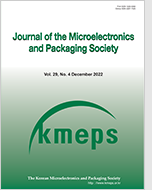
Search
- Past Issues
- e-Submission
-

KCI Accredited Journals KCI 등재지
KCI Impact Factor 0.54
Editorial Office
- +82-2-538-0962
- +82-2-538-0963
- kmeps@kmeps.or.kr
- http://kmeps.or.kr/

KCI Accredited Journals KCI 등재지
KCI Impact Factor 0.54
Journal of the Microelectronics and Packaging Society 2024;31(3):99-104. Published online: Oct, 30, 2024
DOI : doi.org/10.6117/kmeps.2024.31.3.099
With the advancement of power electronics technology and the increasing demand for high-efficiency power semiconductors, silicon carbide (SiC) devices have gained attention as an alternative to overcome the limitations of traditional silicon (Si) semiconductors. SiC devices enable excellent switching efficiency due to their high switching speed. However, parasitic inductance within the power module can cause voltage oscillations and overshoot phenomena, potentially leading to issues with electrical reliability and efficiency. To address these challenges, two approaches were proposed and validated. The first approach involved applying an RC snubber circuit to mitigate the effects of parasitic inductance, thereby improving electrical stability. The second approach focused on optimizing the lead-frame design to reduce parasitic inductance. Both methods were verified through simulations and experiments, demonstrating that the electrical reliability and efficiency of SiC power modules can be simultaneously improved.
Keywords Parasitic inductance, RC snubber, Double pulse test (DPT), Voltage overshoot, Switch loss, Silicon carbide (SiC)